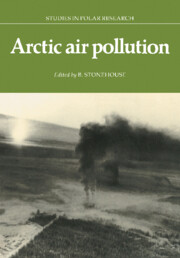Book contents
- Frontmatter
- Contents
- CONTRIBUTORS TO THIS VOLUME
- FOREWORD
- INTRODUCTION: INTERNATIONAL SYMPOSIUM ON ARCTIC AIR POLLUTION
- Part 1 Composition, source areas and transport pathways
- Part 2 Local, regional, global, ecological and climatic implications
- Part 3 Health and ecological issues
- Epidemiology of health effects of air pollution
- Biological effects of low-level ionizing and non-ionizing radiation
- Ecological processes in the cycling of radionuclides within Arctic ecosystems
- Cancer incidence and risk in Alaskan natives exposed to radioactive fallout
- Indoor air pollution and public health concerns
- Exposure to heavy metals in Greenland from natural and man-made sources
- Ecological implications of arctic air pollution
- Part 4 International cooperation and state responsibility
- 5 Conclusions
- Index
Biological effects of low-level ionizing and non-ionizing radiation
Published online by Cambridge University Press: 03 May 2010
- Frontmatter
- Contents
- CONTRIBUTORS TO THIS VOLUME
- FOREWORD
- INTRODUCTION: INTERNATIONAL SYMPOSIUM ON ARCTIC AIR POLLUTION
- Part 1 Composition, source areas and transport pathways
- Part 2 Local, regional, global, ecological and climatic implications
- Part 3 Health and ecological issues
- Epidemiology of health effects of air pollution
- Biological effects of low-level ionizing and non-ionizing radiation
- Ecological processes in the cycling of radionuclides within Arctic ecosystems
- Cancer incidence and risk in Alaskan natives exposed to radioactive fallout
- Indoor air pollution and public health concerns
- Exposure to heavy metals in Greenland from natural and man-made sources
- Ecological implications of arctic air pollution
- Part 4 International cooperation and state responsibility
- 5 Conclusions
- Index
Summary
ABSTRACT. Early in this century it was recognized that large doses of ionizing radiation could injure almost any tissue in the body, but small doses were generally thought to be harmless. By the middle of the century however it came to be suspected that even the smallest doses of ionizing radiation to the gonads might increase the risk of hereditary disease in subsequently-conceived offspring. Since then the hypothesis that carcinogenic and teratogenic effects also have no threshold has been adopted for purposes of radiological protection. It is estimated nevertheless that the risks that may be associated with natural background levels of ionizing irradiation are too small to be detectable. Hence validation of such risk estimates will depend on further elucidation of the dose-effect relationships and mechanisms of the effects in question, through studies at higher dose levels. In contrast to the situation with ionizing radiation, exposure to natural background levels of ultraviolet radiation has been implicated definitively in the etiology of skin cancers in fair-skinned individuals. Persons with inherited defects in DNA repair capacity are particularly susceptible. Non-ionizing radiations of other types can also affect health at high dose levels, but whether they can cause injury at low levels of exposure is not known.
- Type
- Chapter
- Information
- Arctic Air Pollution , pp. 207 - 220Publisher: Cambridge University PressPrint publication year: 1987



